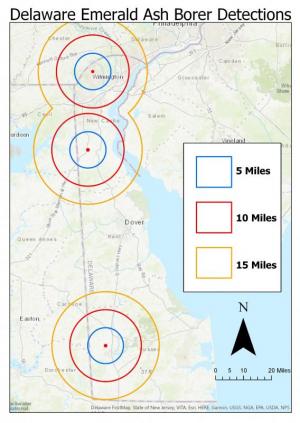Emerald ash borer found at new sites in Delaware
Emerald ash borer, a destructive insect from Asia that attacks and kills ash trees, has been confirmed at two new sites in Delaware: one near Middletown and another near Seaford.
This pest was originally found in northern Delaware in 2016, so the new detections create added urgency for homeowners and municipalities to determine if they have ash trees on their property and decide on possible management options. Current Delaware Department of Agriculture guidelines recommend the removal or treatment of ash trees if located within 15 miles of a known infestation. Because Delaware is geographically small and EAB can go undetected for years, residents are urged to educate themselves now and take action.
“These new detections broaden the areas that we are interested in, but it doesn’t really change our scope of work. Since the first detection in 2016, we have been recommending that property owners within a 5- to 15-mile radius of a positive detection treat trees that they want to keep, or to remove trees if necessary to protect their property and to help limit the spread of the emerald ash borer,” said Stephen Hauss, DDA plant industries environmental scientist II. “USDA’s proposal to end the quarantine regulations does not mean that we stop caring about EAB. We still have not found EAB in Kent County, so we will continue surveying and taking tips from the public.”
For the latest DDA information, residents can go to de.gov/ashtrees for an EAB Fact Sheet and an Ash Treatment Decision Guide.
“Now is the time to be thinking about removing and replacing ash trees, something we’ve been recommending for some time. We’ve been anticipating EAB for many years, but these latest detections show EAB’s spread throughout our state,” said Kesha Braunskill, Delaware Forest Service urban and community forestry program director. “If a particular tree or trees are highly valued by the property owner, chemical treatment may be an option; otherwise removal and replacing ash with a suitable species is our recommendation.”
Symptoms of an EAB infestation can be difficult to notice at first, but usually include: canopy dieback, epicormic sprouting, bark splits, woodpecker damage, and D-shaped exit holes on the bark. Adult beetles feed on ash leaves but actually cause little damage. However, EAB larvae feed on the inner bark of ash trees, disrupting the tree’s ability to transport water and nutrients, and killing the tree in just a few years.
The Delaware Forest Service estimates that ash makes up only about 2 percent of the total tree species in the state, but some communities near urban areas have a higher percentage of ash and could be more adversely impacted.




















































